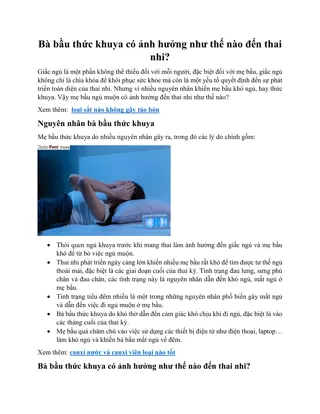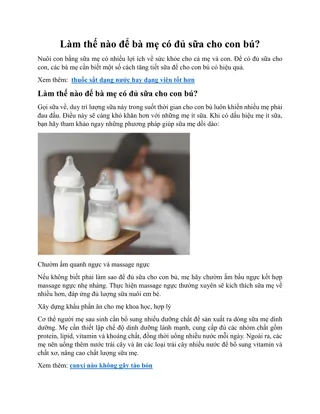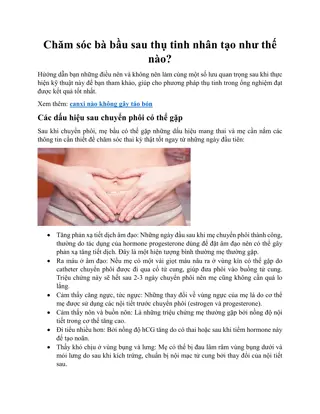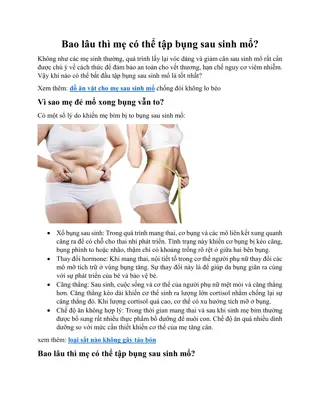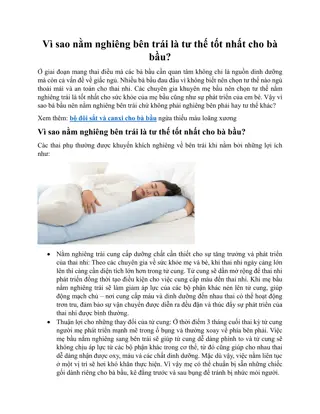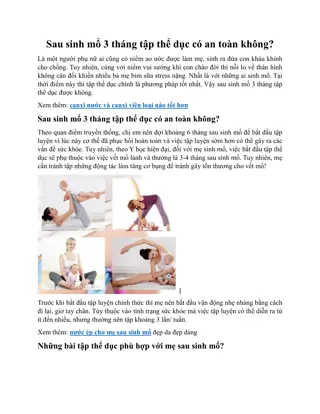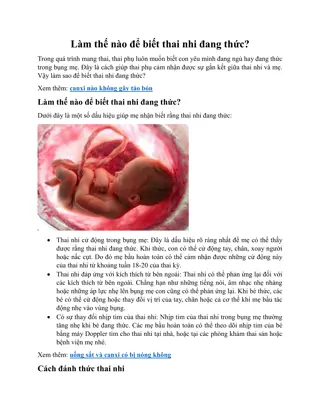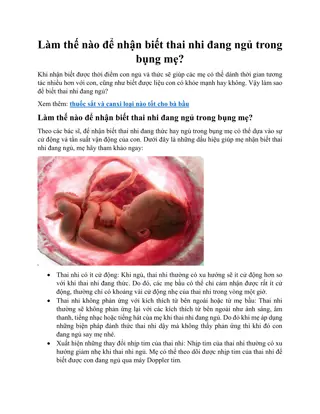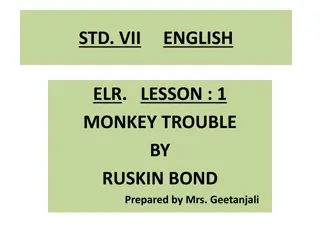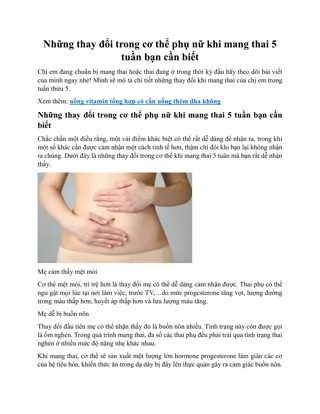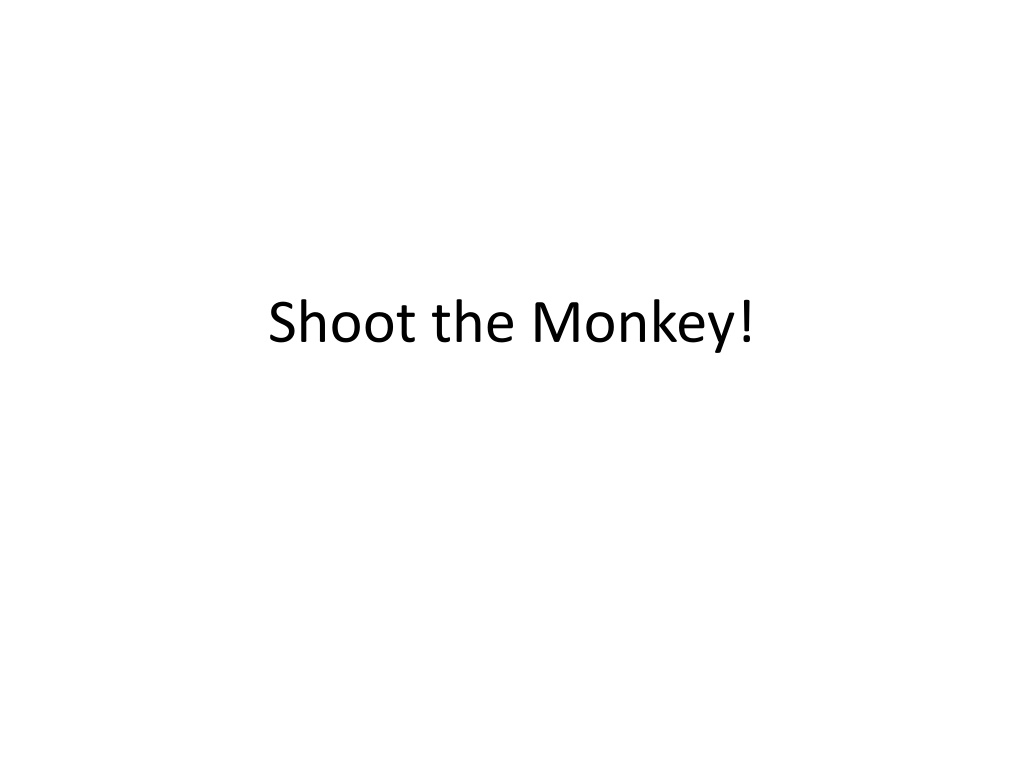
Aim at the Astute Monkey: Projectile Trajectory Analysis
In this scenario, a hunter aims to shoot a monkey in a tree. However, the monkey will drop the branch it's on the moment the hunter shoots. By analyzing the projectile trajectory with gravitational effects, it is concluded that the hunter should aim directly at the monkey to ensure a successful hit.
Download Presentation

Please find below an Image/Link to download the presentation.
The content on the website is provided AS IS for your information and personal use only. It may not be sold, licensed, or shared on other websites without obtaining consent from the author. Download presentation by click this link. If you encounter any issues during the download, it is possible that the publisher has removed the file from their server.
E N D
Presentation Transcript
Shoot the Monkey! A monkey is sitting in a tree. For some reason you want to shoot it. But it is an astute (cheeky, even) monkey and will let go of the branch he is swinging from at the same instant you shoot your gun or arrow or blowpipe or whatever weapon you use. So, where should you aim to guarantee hitting the blighter? Ignoring air resistance, etc.
Monkeys initial position Monkey s position after time ? seconds, falling under gravity, ? m/s2 Path of projectile ? ? ?
Projectile Monkey After time, ? ?sin?? ??2 ??2 Vertical displacement: 2 2 ?cos?? ? Horizontal displacement: ? Time for projectile to reach fall-line of monkey ? = ?cos? Vertical displacement at ? = ? cos ?: ??2 ??2 ?tan? ? 2?2cos?2 2?2cos?2 Equating vertical displacements gives: ?tan? = Re-arranging gives: tan? = ? So, just aim at the monkey!
Projectile Monkey After time, ? ?sin?? ??2 ??2 Vertical displacement: 2 2 ?cos?? ? Horizontal displacement: ? Time for projectile to reach fall-line of monkey ? = ?cos? Vertical displacement at ? = ? cos ?: ??2 ??2 ?tan? ? 2?2cos?2 2?2cos?2 Equating vertical displacements gives: ?tan? = Re-arranging gives: tan? = ? So, just aim at the monkey!
Another way of looking at it is to consider the position vectors of each object and note how they change with time. Monkey s initial position Considering the monkey s position vector first: ???????
Another way of looking at it is to consider the position vectors of each object and note how they change with time. Monkey s initial position Now considering the projectile s position vector: Path of projectile ???????????
Another way of looking at it is to consider the position vectors of each object and note how they change with time. Monkey s initial position Considering both position vectors: ??????? ???????= ??????????? so collision here ???????????
Algebraicly: ?cos?? ?sin?? 1 ? 2??2 ???????= ???????????= 1 2??2 For a collision ???????= ??????????? ?cos?? ? sin?? 1 ? 2??2 = So 1 2??2 Equating horizontally: ? = ?cos?? ? So ? = ? cos ? 1 2??2= ?sin?? 1 Equating vertically: 2??2 So = ?sin?? ? = ?sin? = ?tan? ? cos ? ???? =? ?
Will the hunter hit his prey? HA, YOU MISSED ME!
Will the hunter hit his prey? AAAARGHHHH!
Will the hunter hit his prey? First scenario with line of fire
Will the hunter hit his prey? Second scenario with line of fire
This scenario hits the target (line of fire is on the target) This scenario does not hit the target (line of fire is not on the target)
No matter what initial velocity the projectile has the only criteria for hitting the target is that the projectile is aimed directly at it. The initial velocity only determines when the target is hit. A small velocity will obviously take longer and so hunter and target should be on opposite sides of a very deep canyon!
Another way of thinking about it is to note that each object (projectile and monkey) have identical vertical acceleration gravity. So, subtract that motion from each object and analyse. It is now as though gravity is zero so the answer of aiming directly at the target becomes obvious. Each object has fallen the same distance.
Shoot the Monkey! The instant you shoot, the monkey lets go and falls to the ground. What angle ensures you hit him? 9.81 ms-2 33.92 m 21.5 ms-1 ? =? 26.5 m (Not to scale) SIC_26
Shoot the Monkey! The instant you shoot, the monkey lets go and falls to the ground. What angle ensures you hit him? 9.81 ms-2 35.2 m 23.5 ms-1 ? =? 27.5 m (Not to scale) SIC_26
Shoot the Monkey! The instant you shoot, the monkey lets go and falls to the ground. What angle ensures you hit him? 9.81 ms-2 36.48 m 25 ms-1 ? =? 28.5 m (Not to scale) SIC_26
Shoot the Monkey! The instant you shoot, the monkey lets go and falls to the ground. What angle ensures you hit him? 9.81 ms-2 37.76 m 26.2 ms-1 ? =? 29.5 m (Not to scale) SIC_26
Shoot the Monkey! The instant you shoot, the monkey lets go and falls to the ground. What angle ensures you hit him? 9.81 ms-2 41.6 m 26.2 ms-1 ? =? 32.5 m (Not to scale) SIC_26
Shoot the Monkey! The instant you shoot, the monkey lets go and falls to the ground. What angle ensures you hit him? 9.81 ms-2 48.0 m 30 ms-1 ? =? 37.5 m (Not to scale) SIC_26
Shoot the Monkey! The instant you shoot, the monkey lets go and falls to the ground. What angle ensures you hit him? 9.81 ms-2 49.2 m 31.2 ms-1 ? =? 38.5 m (Not to scale) SIC_26
Shoot the Monkey! The instant you shoot, the monkey lets go and falls to the ground. What angle ensures you hit him? 9.81 ms-2 50.56 m 32.2 ms-1 ? =? 39.5 m (Not to scale) SIC_26
Shoot the Monkey! The instant you shoot, the monkey lets go and falls to the ground. What angle ensures you hit him? 9.81 ms-2 51.84 m 33.4 ms-1 ? =? 40.5 m (Not to scale) SIC_26
Shoot the Monkey! The instant you shoot, the monkey lets go and falls to the ground. What angle ensures you hit him? 9.81 ms-2 53.12 m 35.4 ms-1 ? =? 41.5 m (Not to scale) SIC_26
Shoot the Monkey! The instant you shoot, the monkey lets go and falls to the ground. What angle ensures you hit him? 9.81 ms-2 54.4 m 36 ms-1 ? =? 42.5 m (Not to scale) SIC_26
Shoot the Monkey! The instant you shoot, the monkey lets go and falls to the ground. What angle ensures you hit him? 9.81 ms-2 55.68 m 39.7 ms-1 ? =? 43.5 m (Not to scale) SIC_26









